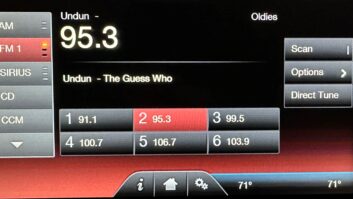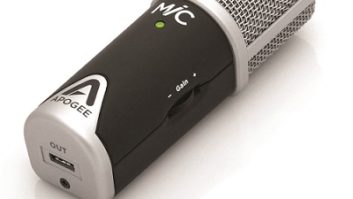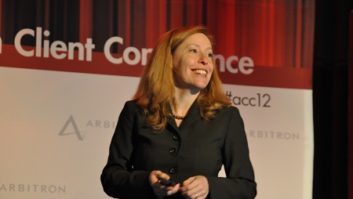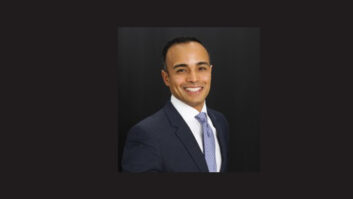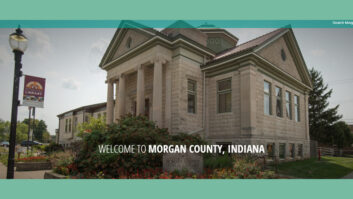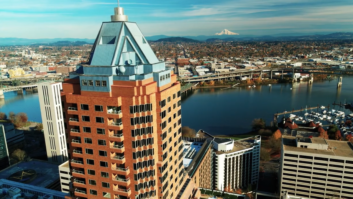
You can improve your station’s energy efficiency without incurring extraordinary expenses.
I moderated a panel on this topic at the spring NAB Show this year. “Going Green, Seeing Black” focused on some of the ways that broadcasters are becoming more environmentally aware.
Panelists included the founding principal of an international architecture firm, the general manager of a Salt Lake City public radio station and the director of engineering for two commercial AMs in San Francisco. Here are highlights.
Green buildings, practices
While many broadcasters want to go green and start out with solar panels or wind turbines, a sound environmental plan starts with tightening down the existing building.
This includes activities such as replacing over-rated HVAC units with properly-sized devices, use of thermal imaging to find gaps around windows and doors, and sealing them up, the use of motion sensors to control lighting and heat, and installing LED lighting and energy-efficient sprinkler heads for landscaping. Additionally, installing a “cool roof” can save over 30 percent on air conditioning costs.
The overarching principal is to look at the simple, boring solutions first. In many instances, so much money is saved through these measures that installing solar or wind may not be as pressing an issue, or the savings may make an installation more affordable.
Once you’ve addressed the basics, you can attend to long-term goals through strategic planning. This can include rainwater catchment systems for irrigation and cooling towers, installation of efficient toilets and faucets, building automation systems and providing green plants.
Rebates are available for many of these improvements, although most people don’t know where to look or how to apply. Information on rebates usually is available from local utilities or NGOs. Green consultants are available in many areas to assist with the process.
Our audience members asked about funds that are available from the economic stimulus package. At this writing, little of this money is earmarked for improving commercial buildings.

Joe Talbot described the solar power installation at KGO’s transmitter site in San Francisco. Green business practices in operations can include activities such as rethinking paper procurement policies, where recycled materials are purchased from a local supplier, or for larger organizations, developing a paperless office.
Green employment practices can include benefits such as giving employees a half-day off to volunteer at an environmental cause of their choosing or donating money to a green cause of an employee’s choice. Employees may be given bonuses for ideas that are adopted to reduce waste or improve energy efficiency.
Big savings
Tony Argibay, AIA, founding principal of architecture firm Meridian Design, discussed LEED (Leadership in Energy and Environmental Design) certification and the importance of green building.
Key components of green building include site planning, water management, energy consumption, material use and indoor environmental quality.
LEED is a building certification system created by the U.S. Green Building Council. The ratings systems are developed by committees consisting of various practitioners in building and construction.
Its goal is to transform the way buildings and communities are designed, built and operated, creating a healthy and prosperous environment that improves the quality of life.
Argibay emphasized that building green is important because of the amount of resources that buildings consume: 40 percent of the country’s primary energy use, 72 percent of electricity consumption, 39 percent CO2 emissions and 13 percent of potable water consumption.
A properly designed green building can reduce energy use by 24–50 percent, CO2 emissions by 33–39 percent, water use by 40 percent and solid waste by 70 percent.
There are also human benefits to green buildings. Argibay added that research indicates a 2–16 percent increase in worker and student productivity.
Xeriscaping
Donna Land Maldonado, general manager of public station KRCL(FM) in Salt Lake City, described many of the environmentally-friendly changes made to the station’s property since it was purchased in 2000.
The grounds originally had traditional landscaping: grass, trees and shrubs. With an all-volunteer staff at the station, Maldonado feared the lawn wouldn’t be taken care of. A decision was made to do a landscape makeover using “xeriscaping.”
The term means water conservation through creative landscaping. Xeriscape is a registered trademark of Denver Water. The benefits of xeriscaping include reduced water consumption, less landscape maintenance and reduced use of fertilizers and pesticides.
Community volunteers came to the site and removed the existing landscaping. Next, KRCL employed Waterwise Landscape Design, a local landscaping company, for the design and makeover. Waterwise located a nursery that was willing to donate native plants. Next, a water-efficient drip irrigation system was installed. The final piece was the transplanting of a bristlecone pine. The project cost around $2,000 in 2000.
KRCL partnered with Utah Power’s Blue Sky Initiative and began purchasing electricity from wind power. Over the past four years, the station has increased its purchases till they are now at 100 percent.
Maldonado said that when the building was purchased, it had an unreliable generator system. This was replaced with a solar power backup system. The panels are constantly online, reducing KRCL’s demand from the grid. At the same time, the panels power 10 batteries, which allow the station to broadcast for 12 hours in the event of a prolonged power outage.
Existing lighting fixtures in the KRCL building have been replaced with energy-efficient devices. The station took advantage of a rebate program available through Utah Power’s FinAnswer, resulting in a savings of 57 percent.
Maldonado adds that the station has installed a bike rack to encourage pedal power. It recycles paper and airs numerous public affairs programs and public service announcements for green causes. The next step for KRCL is installation of low-flow toilets and waterless urinals.
Know your dealer
Joe Talbot, director of engineering at Citadel’s KGO(AM) and KSFO(AM) in San Francisco, talked about the installation of a 20 kW solar power installation at the KGO transmitter site on the south end of the San Francisco Bay. The project was a partnership with PG&E, which pointed the station to vendors, rebates and tax credits.
Several issues came up during the planning process, he said.
City planners expressed concerns that reflections from the solar panels would blind drivers on a nearby freeway. The station explained this could not happen. There was a requirement for soil samples to be analyzed. The results came back with high salinity — not surprising since the site is in a salt marsh. These delays put construction into the rainy season, which resulted in more delays.
The project finally worked. KGO invited Speaker of the House Nancy Pelosi to the dedication and she threw the switch to inaugurate the solar project.
Talbot noted that an important part of the project was getting the word out on solar power. KGO aired a series of special reports on solar power, including information on rebates and tax credits that were available through PG&E. It also maintained a blog on the station Web site to keep listeners informed as the project progressed.
Talbot’s advice to stations contemplating renewable energy is simple. “Get to know your local wind and solar dealers. They know what is available in your area and what works best.”
The author is principal at Interactive Media Concepts and a regular Radio World contributor. Read more “Green Radio” articles under the Columns tab at radioworld.com.





